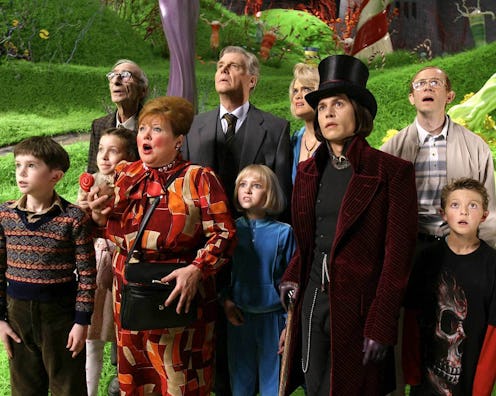Books
Well, This May Be the Creepiest Book Cover Ever
You remember Roald Dahl's classic book Charlie and the Chocolate Factory as a whimsical, fantastic story from childhood — a sugar-coated dreamscape that's stored comfortably in your nostalgia bank. You probably don't associate it with the words "disturbing" or "gross."
A new cover for Charlie and the Chocolate Factory was released this week, and, controversially, that's the reaction it's causing. It features the image of a young girl, made-up doll-like, wrapped in pink boas on the knee of a half-hidden woman. The cover has been called "inappropriately sexualized," "creepy," and "misleading" by authors, other publishers, and the public. Its publisher, Penguin, has been forced to release a statement publicly defending the redesign.
The cover photograph wasn't taken just for the book — it's actually from a 2008 magazine article called, a bit upsettingly, "Mommie Dearest," in a French magazine — but its choice is a radical departure from classic Dahl covers, which usually feature the sweet and maniacal drawings of his collaborator Quentin Blake.
But neglecting Blake's illustrations isn't the only thing upsetting onlookers. The image has been attacked for being radically inappropriate, being "Lolita-like," and adding a shade of adult voyeurism to a children's classic (though a twisted one).
The reactions have run a wide gamut, from "impossible to defend" to "terrifying." Other comments on Penguin's Facebook page, where the cover was unveiled, call it "misleading," "misjudged on every level," "distasteful and disrespectful," and "totally ridiculous."
Many responses, though, focus on the inappropriateness of the image's strangely nymphet-ish quality. Author Giles Paley-Phillips called it "more like Lolita," and author of Chocolat Joanne Harris unleashed a series of Tweets asking if recently convicted pedophile Rolf Harris was going to be involved:
Still, Penguin stands by its cover. The picture wasn't, they pointed out, for a children's edition, but for an "adult" version that would be sold as part of the Penguin Modern Classics series. The book, plus other classics like Alice In Wonderland, was redesigned for release "in recognition of the book's extraordinary cultural impact."
"This new image for Charlie and the Chocolate Factory looks at the children at the center of the story," a statement from Penguin included, "and highlights the way Roald Dahl's writing manages to embrace both the light and the dark aspects of life."
Darkness, indeed. Dahl often had an aspect of the dark in his children's books, from embracing some less fun aspects of childhood existence (poverty, orphans, and family abuse, for instance) to exhibiting a ghoulish streak in narrative. (Anybody else have nightmares about the Vermicious Knids?) These days his legacy also includes his more adult fiction, which was definitely bent towards the bizarre and horrid — so we're even more aware of his creepy side. But does Charlie and the Chocolate Factory's particular brand of strangeness match up with the image Penguin has given it?
It looks more like a publishing stunt than anything — I'd be willing to guess that the public outrage has given pre-sales a boost — but it also seems like a weird attempt to give a veneer of adult glamour and sophistication to a book that says adults are, by and large, strange and untrustworthy. Think of all of Charlie's hapless, spoiled-rotten fellow winners, all given appropriately grotesque punishments: their real weakness, Dahl implies, isn't their personal greed or selfishness, it's their horrid parents. Charlie and the Chocolate Factory is a celebration of childish exuberance and nonsense. This cover, then, doesn't exactly fit.
Penguin has said that the girl is meant to represent not Veruca Salt or Violet Beauregarde, but the "twisted" family relationships in the book. Now that is a depressingly adult aspect to take away from a story about a boy (spoiler) inheriting a chocolate factory. For all the bright colors, it's a sad and claustrophobic image.
But the vacant vulnerability of the girl in the photograph is what seems most at odds with Dahl's storytelling ethics. The boys and girls of Charlie and the Chocolate Factory, and of his fiction in general, sometimes aren't particularly nice, but they have character. And they are active participants: they choose their future, plot things, suffer, and carry on. From Matilda to James and the Giant Peach, Dahl seemed to value that his kid protagonists not be inert objects or vessels for adult ideas, but vital beings.
That is the most unsettling bit: not that the girl is dressed up, but that she's completely blank and controlled. Dahl never created blank children — it was one of his biggest legacies to storytelling. To put one on the cover of one of his most famous stories is both upsetting and poorly judged. Veruca Salt would never stand for it.
Images: Warner Bros. Pictures; Penguin; Quentin Blake
